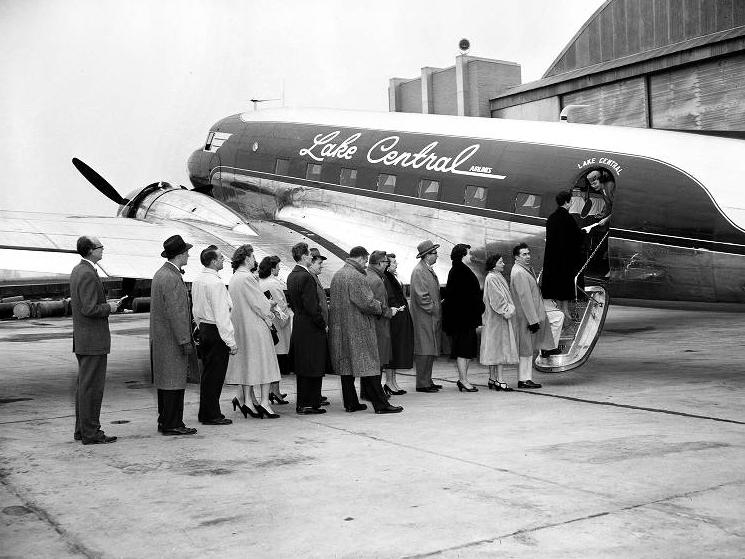Lake Central Airlines was established in May 1949, as Turner Airlines to provide short-haul service from its base at . The flamboyant had a vision of air service for smaller communities, but he could not overcome the financial difficulties. By December 1950, Turner sold his controlling interest in the fledgling airline and it changed its name to Lake Central Airlines. The new corporation was organized under Delaware law, but its offices and chief maintenance base were always located in Indianapolis and it was generally identified as a “Hoosier airline,” at least within Indiana.

Service began on November 12, 1949, on a route from Indianapolis to Grand Rapids, Michigan. Within two years, Lake Central operated regular service over a region extending from Louisville and Cincinnati on the south to Chicago and Grand Rapids on the north.
Ownership and management were unstable for several years. Turner sold control to the Weesner family from Nebraska, which had conflicts with the Civil Aeronautics Board (CAB) over other airline operations. Control passed temporarily to an Indianapolis insurance executive, Harry V. Wade, under a voting trust arrangement. Both Wisconsin Central and Ozark airlines attempted to take over Lake Central when a CAB examiner found the current management unfit to continue operations.
Disputes were not resolved until September 1954 when a majority of the airline’s employees purchased 97 percent of the voting stock. They used payroll deductions to pay $81,000 for their shares.
Lake Central operated successfully under the regime of detailed federal regulations, winning permission to expand service to a total of 50 cities. It flew as far west as Chicago and St. Louis and as far east as Buffalo and Baltimore but concentrated its service in Indiana and Ohio.
Passenger and freight traffic increased rapidly through the 1950s and early 1960s, but Lake Central remained dependent upon its federal subsidy. In 1960 Lake Central began flying 52-passenger Convair aircraft, which were manufactured by Convair—later a division of General Dynamics—that were smaller than most contemporary airliners but somewhat faster. Larger airlines no longer needed this type of plane. Lake Central replaced the Convair aircraft’s conventional piston engines with faster and more efficient turboprop engines manufactured in Indianapolis by the .
Lloyd Hartman became president in 1962 and energetically expanded Lake Central’s routes and improved its service. Meanwhile, the CAB began to implement a policy of reducing subsidy requirements by assigning busier and presumably more profitable routes to the smaller airlines. Hartman agreed completely with the policy but soon faced a very difficult financial problem because the additional and often competitive routes required larger, faster, and more expensive aircraft.
The entire local service industry had for years sought a replacement for its aging Douglas DC-3s, a propeller-driven airliner that it widely used, and Hartman bound Lake Central’s future to the Nord-262, a newly designed turboprop aircraft imported from France. Not only would Lake Central be the first North American airline to fly the Nord, but it also secured exclusive sales rights for most of North and South America. The 27-passenger Nord cost $550,000 each, and Lake Central went deeply into debt to finance the purchase of 12 of the aircraft to serve its lightly traveled routes. For its busiest routes, Hartman announced plans to acquire 111-passenger Boeing 737 twin-jet aircraft by 1968, at a cost of $3,000,000 each. Indianapolis banks declined to finance the new aircraft purchases, so Lake Central turned to out-of-town banks.
The untried Nord-262s soon developed serious troubles with in-flight engine failures that injured several passengers. All 12 planes were withdrawn from service in August 1967 for major overhauls. This well-publicized operating problem, combined with continuing financial difficulties beyond the resources of the employee ownership program, revived rumors of a merger to save the airline.
In April 1967, Hartman was suddenly removed as president by the Bass family of Dallas, which had quietly acquired ownership of the common stock from the employee group. The newly installed president, L. Thomas Ferguson, soon announced ambitious plans for continued expansion financed by additional bank loans and began an extensive advertising program to restore Lake Central’s tarnished reputation.
Within six months, however, the new owners announced a merger with Allegheny Airlines (later USAir), the largest of the nation’s nine local service carriers. Ferguson returned to his former position as a vice president at Allegheny when the merger became effective on July 1, 1968. Lake Central, often called “Late Central” by disappointed passengers, quickly faded from memory when Allegheny closed its Indianapolis base and sold its ill-fated Nord-262s.

Help improve this entry
Contribute information, offer corrections, suggest images.
You can also recommend new entries related to this topic.




